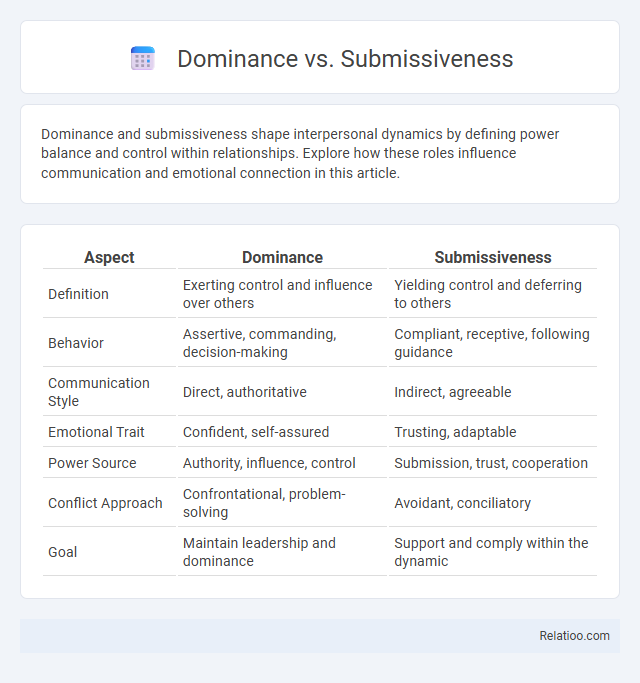Dominance and submissiveness shape interpersonal dynamics by defining power balance and control within relationships. Explore how these roles influence communication and emotional connection in this article.
Table of Comparison
| Aspect | Dominance | Submissiveness |
|---|---|---|
| Definition | Exerting control and influence over others | Yielding control and deferring to others |
| Behavior | Assertive, commanding, decision-making | Compliant, receptive, following guidance |
| Communication Style | Direct, authoritative | Indirect, agreeable |
| Emotional Trait | Confident, self-assured | Trusting, adaptable |
| Power Source | Authority, influence, control | Submission, trust, cooperation |
| Conflict Approach | Confrontational, problem-solving | Avoidant, conciliatory |
| Goal | Maintain leadership and dominance | Support and comply within the dynamic |
Understanding Dominance and Submissiveness
Dominance and submissiveness represent fundamental dynamics in human behavior and social interactions, where dominance involves exerting control or influence, while submissiveness entails yielding or deferring authority. Understanding dominance requires examining psychological motivations, such as the desire for power, control, and social hierarchy, alongside behavioral expressions like assertiveness and leadership. Submissiveness, characterized by compliance, cooperation, and acceptance of others' directives, plays a crucial role in maintaining social harmony and adaptive interpersonal relationships.
The Psychological Roots of Power Dynamics
Power dynamics in relationships stem from deep psychological roots involving individual needs for control, security, and identity. Dominance often arises from a desire to assert authority and maintain self-esteem, while submissiveness can be linked to trust, surrender, or a need for safety within a hierarchical structure. Subjugation involves the internalization of lower status, frequently influenced by past trauma, learned helplessness, or social conditioning that perpetuates power imbalances.
Dominance vs Submissiveness in Relationships
Dominance and submissiveness in relationships involve power dynamics where one partner takes a leading role while the other adopts a more yielding position, influencing decision-making and emotional expression. Healthy dominance fosters mutual respect and clear boundaries rather than coercion, whereas submissiveness emphasizes trust and communication without loss of autonomy. Understanding these roles enhances intimacy by aligning partners' needs and reinforcing consent within relational dynamics.
Social and Cultural Influences on Power Roles
Social and cultural influences significantly shape power roles, where dominance is often associated with leadership and authority in hierarchical societies, reinforcing status and control. Submissiveness can be culturally valorized in collectivist cultures that emphasize harmony, respect, and hierarchy, leading individuals to accept or endorse lower power positions. Subjugation, distinct from voluntary submissiveness, results from systemic oppression and institutionalized inequality, embedding power imbalances into social structures and perpetuating marginalized group disparities.
Dominance and Submissiveness: Myths vs Facts
Dominance and submissiveness are often misunderstood through myths such as dominance equating to aggression and submissiveness implying weakness, whereas facts reveal these traits involve complex social behaviors rooted in communication and consent. You can foster healthy relationships by recognizing that dominance often reflects confidence and leadership while submissiveness signals trust and emotional openness, not inferiority. Understanding the distinction from subjugation, which is coercive control lacking mutual respect, helps dismantle harmful stereotypes and promotes balanced interpersonal dynamics.
Healthy Boundaries in Power Dynamics
Establishing healthy boundaries in power dynamics requires clear communication and mutual consent between dominant and submissive roles to ensure respect and emotional safety. Dominance involves assertive control, submissiveness embraces willing surrender, and subjugation implies oppressive control lacking consent, often leading to harm. Recognizing these distinctions supports balanced interactions where power exchange enhances trust without coercion or abuse.
Communication Strategies for Balanced Relationships
Effective communication strategies in relationships with dynamics of dominance, submissiveness, and subjugation emphasize clear boundaries, active listening, and mutual respect to ensure emotional safety and understanding. Employing assertive communication allows dominant individuals to express needs without overpowering, while submissive partners can convey consent and limits, preventing misunderstandings. Integrating regular check-ins and open dialogue fosters equality and prevents the escalation of subjugation, promoting a balanced and consensual partnership.
The Role of Consent in Dominance and Submission
Dominance and submission dynamics center on mutually agreed-upon roles where consent is essential to ensure safety and respect. Consent distinguishes consensual dominance and submission from subjugation, where control is imposed without agreement or autonomy. Clear communication and ongoing consent maintain ethical boundaries and empower participants within dominant-submissive relationships.
Navigating Challenges and Misunderstandings
Navigating challenges in dominance, submissiveness, and subjugation requires clear communication and mutual consent to prevent misunderstandings that can damage trust. You must establish boundaries and regularly check in to ensure that power dynamics remain consensual and healthy, avoiding confusion between voluntary submission and coercion. Awareness of emotional needs and respect for autonomy are crucial to maintaining balance and preventing misuse of power in these relationships.
Empowerment and Growth through Power Dynamics
Dominance, submissiveness, and subjugation represent distinct power dynamics that shape personal empowerment and growth by influencing self-awareness and interpersonal boundaries. Embracing dominance fosters assertiveness and confidence, while healthy submissiveness encourages trust and emotional intelligence, both contributing to balanced relationships. Conversely, subjugation limits empowerment by enforcing control and dependency, hindering individual development and autonomy.

Infographic: Dominance vs Submissiveness
 relatioo.com
relatioo.com